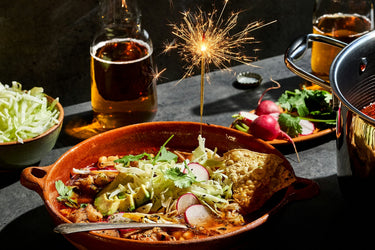Pozole Rojo 101

If you’re seeking a big-batch, celebratory dish, Mexico City–based chef and writer Scarlett Lindeman says to look no further than pozole, a hearty corn and pork stew beloved throughout Mexico and many parts of the United States.
“Pozole is iconic in Mexican cuisine, and every state has its own variation,” said Lindeman. “It’s a great pick for entertaining because it can be easily multiplied to serve more.” Though not necessarily a holiday-specific dish, it’s commonly served at this time of year, she said. “People are with their family and big groups of friends. It’s almost impossible to make pozole for less than six people and is often made for more like 20 people.” In other words, pozole is a great pick for cold weather-celebrations when people want a sturdy, comforting, hot stew.
Lindeman spent two decades in restaurant kitchens, writing about food and attending NYU’s Graduate Center to research diasporic Mexican foodways in the United States before heading south to build a life in Mexico's ancient capital and deepen her Spanish language skills.
“I left cooking to pursue my PhD,” she says, “but eventually put my PhD on the back burner to return to the kitchen.” Her first restaurant Cicatriz—Spanish for "scar," her nickname—and second spot Ojo Rojo Diner have become hotspots.
Lindeman refers to cooking as her "praxis," an academic term that describes day-to-day actions and practices. In her case, that’s the work of making food and interacting with others in the kitchen or writing about and researching Mexican cuisine. Here, she shares a bit of pozole's rich and interesting history, plus key tips for making a great one.
Dating back to the Aztecs, pozole served as both sustenance and a symbolic component in religious rituals (we’ll leave you to do some googling to learn the unappetizing rest of the history). The arrival of Spanish colonists cued the dish's evolution into its current form, a delicious soup made with long-cooked pork broth and maíz cacahuazintle, or hominy. These dried giant corn kernels are the heart of the stew, which is reflected in the name. The word pozole derives from the original Nahuatl (or Aztec) word pozol, which describes the foamy or frothy consistency of liquid after boiling dried hominy, and the Aztec term for the stew made with the corn and meat, pozolli, morphed into the Spanish word "pozole" now in wide usage.

You’re likely to find pozole in one of three forms: red (as in our recipe for Pozole Rojo) made with guajillo and ancho chiles; green pozole made with (of course) green chiles and tomatillos; and white, a milder version of the stew with no chiles at all. (To make a white pozole, follow our recipe and don’t add any chiles.)
“Guajillo is the most commonly used chile,” said Lindeman. All Mexican supermarkets and most US supermarkets will carry guajillos, she said, as they form the basis for a typical salsa roja. Anchos, meanwhile, lend body and smokiness, but if you fear the heat, rest assured that both chiles are quite mild. Craving a bowl of fiery pozole? Ground, dried chile is also commonly served on the side.
Depending on the kind of hominy you use, the process and timing of making the stew will differ. In Mexico City, it’s common to find dried or par-cooked, shrink-wrapped bags of maíz cacahuazintle, said Lindeman, while in the US you’re more likely to find canned hominy. If you pick the par-cooked version, that initial simmering to get the corn soft and open can take up to 8 hours. However, you can easily take a short cut with canned hominy, which only needs about 30 minutes of simmering. For those who want to go the old-school route, brands like Rancho Gordo and Masienda sell dried hominy. Soak them overnight as you would beans, Lindeman suggested.
The stock that forms the base of the soup often calls for pig's head, while our version uses pork spare ribs and bone-in pork shoulder–but Lindeman stressed that you should tailor it to your preference, swapping in leaner or richer meats. In fact, this is central to the ethos of pozole. “The main thing is that everybody doctors the bowl according to their preference,” she said. “I like shredded cabbage in mine, but shredded lettuce is common, too.” Other toppings include tostadas, radish, dried oregano and lime wedges. Don’t forget to serve extra red sauce to drizzle on top of your bowl. Cheese is less common, she said, but if you want something creamy, go for a dollop of crema. “Most people will top the bowl how they like it, and on the side they’re having tostadas spread with a little cream and some queso fresco.”
Lindeman stressed that the best part of pozole is that it’s hard to go wrong. Gather your friends and family, set out bowls of your favorite toppings, and enjoy.





